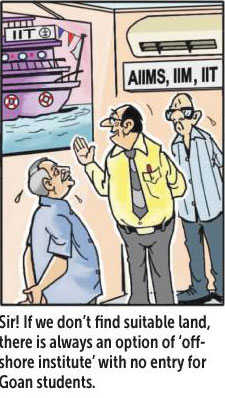
Ajit John
On Sunday the world will celebrate World Portuguese language Day. The day is marked through a range of musical performances, literature readings, competitions, cultural shows, art exhibitions, lectures, plays, and other cultural events worldwide in order to highlight the use and spread of the Portuguese language around the world. It was officially established in 2009 by the Community of Portuguese-speaking Countries (CPLP) - an intergovernmental organization that has been in official partnership with UNESCO since 2000. It brings together peoples with the Portuguese language as one of the foundations of their specific identity - to celebrate the Portuguese language and Lusophone cultures. In 2019, the 40th session of UNESCO’s General Conference decided to proclaim May 5 of each year as ‘World Portuguese Language Day’.
The Portuguese language is not only one of the most widespread languages in the world, with more than 265 million speakers spread through all continents, but it is also the most widely spoken language in the southern hemisphere. Portuguese remains, today, a major language of international communication and a language with a strong geographical projection, destined to increase. In Goa with the history of the State, the appeal of the language is increasing.
People involved in teaching the language had interesting viewpoints as to the popularity of the language. Franz Schubert Cotta from the Goa University Portuguese department said the language was popular among the older generation but thirty years ago, the Fundacao Oriente started a popular singing competition. This encouraged the youth to learn and participate in the competition. This encouraged them to learn the language. He said they were now picking up the language as the third language. These activities, had given an impetus to the language. People had come to the language through music.
He said they had around 50 students across two programmes, BA and MA. Due to the BA course, the numbers had increased. Earlier with the MA programme, the numbers would sometimes cross double digits. He said, “Currently, we have a number of North Indians studying.The percentage of Goans who are learning the language is very small. In Goa, we have the opportunity to be translators or teaching the language in schools in the higher secondary. Teachers are funded by Fundacao Oriente. The scope as you can see is limited in Goa. Outside Goa however they have huge opportunities. There is huge demand in multinationals like IBM, HP, Accenture and Amazon for eg. They employ Portuguese language experts and pay well for these jobs. This has become very lucrative. Many of them come from places like Bihar, Dehradun, Haryana and Delhi”.
Delfim Correia da Silva, director of CLP-Camões in Goa and a visiting lecturer at the Department of Portuguese and Lusophone Studies, Goa University said the university had different programmes. In the BA programme, he said they had around 20-25 students and 6 in MA. There were also students in the various certificate courses. In all, there were around 150 students. Since he came on board in 2008, the number of students had increased but after the pandemic he said many had come online. A large number he said were from other states of India. Now half of them were Goans.
Speaking about Portuguese in Goa, he said, it was important for students in research, law, architecture and other similar fields. India, he said, is a member of CPLP (Community of Portuguese Language Countries). He said, “Last year, we had the first Lusophone Festival organised by the Central Government which selected Goa. Goa can be a bridge between Europe and India. There is no doubt of the popularity of Portuguese. It is important in the rich diversity of Goa”.
Loraine Alberto, another teacher at the University said the language was very popular in the school at the higher secondary level. She said the numbers had increased over the years. However, she conceded that at the college and university levels, numbers would drop because the students would think along conventional lines and think of subjects like English, History which she said were the stereotypical choices. The Bachelor course in Portuguese was new and had a very good number of students but the number of Goans were very few. For the masters course, the number of Goans were good. It was the fifth most spoken language in the world and when one learned a new language one was introduced to a new culture.
There are several organisations and individuals who have devoted their lives to teaching the language. Kevin Stephen Cotta of the Varca Commercial Centre based in Varca said most people in Goa learned Portuguese as a third language. The younger generation was interested and those who went beyond the school curriculum were coming in to study. He said the numbers were increasing over the years and people loved the language and it was also easy to learn. He said, “We Goan use a lot of words in Konkani which are also used in Portuguese. Over the years very few families spoke the language at home with the older generation speaking the language but the younger generation would not continue that culture. We have classes everyday. On any day we have 10 to 12 students. The eldest student was 79 years old. We had a 76 year old student who learned the language in school and then lost touch. Later in life she came over to refresh her memory.”
For Elayne Nadya Monteiro Prabhu, a teacher of the language for around 20 years, most of her students are professionals. Many are advocates and there was even a priest who learned from her. She said many learned the language to get better prospects abroad. She now had around ten students and the situation had gone back to normal after the problems caused by the pandemic. She said it was a sweet language and it was all in the process of learning the language. People she said learned the language and managed to get jobs in Portugal and other Portuguese speaking countries for a better salary. She said the language had a charm and demand would always be there to learn it.
A teacher of the language in two schools in Mapusa, Carina DeSousa said she had 24 students in one school and 20 in the other. According to her, the popularity of the language had not gone down with many families still speaking the language. She had students who were not Goan and they belonged to all religions.
Orty Soares, President of the Indo- Portuguese Society said the language was non-native but the schools were now giving the option of learning the language. She said there was great interest in teaching and learning in the school. The younger generation wanted to learn the language. She said, “We have a course every year which is over 100 hours and last year, we had 60 students from all over. This year too, we intend to have it in July and we will be advertising it. I am confident about its future. We had a student from Mangalore who would come twice a week without fail to learn the language.”
Bhagirath G Shetye, Chairman, Goa Board of Secondary and Higher Secondary Education said in the Class 10 exams, around 300 students appeared but that number saw a drop in Class 12 which saw 250 students appearing.
Perhaps the motivation for learning a new language is jobs. Celine, a teacher for thirty years, said learning a new language meant the possibility of working in a multinational or in migration. She said whatever that could be done to popularize the language had been done by Fundacao Oriente. She said it depended on the family, if they spoke it then the children would.
It is obvious the language has an appeal with certain sections of society and its popularity may ebb and flow due to reasons that may be prevalent at that point in time. But it would continue to live and breathe in Goa.
